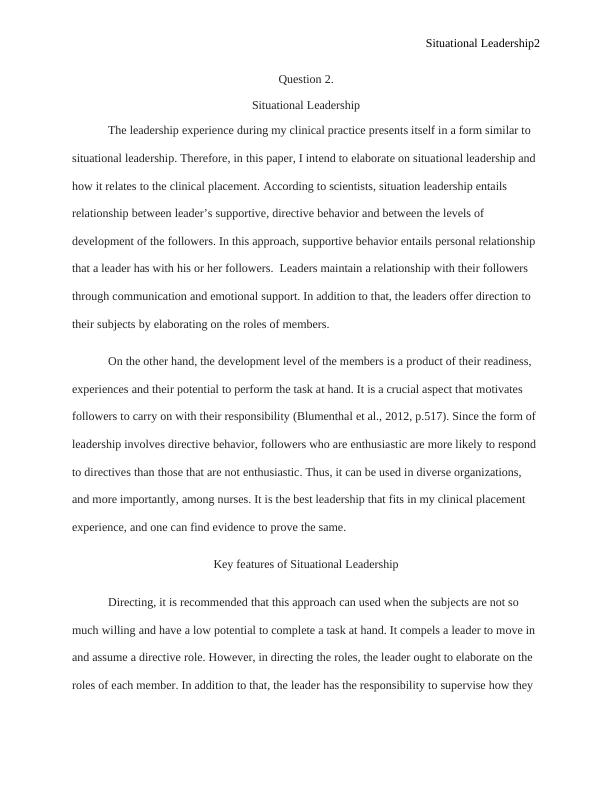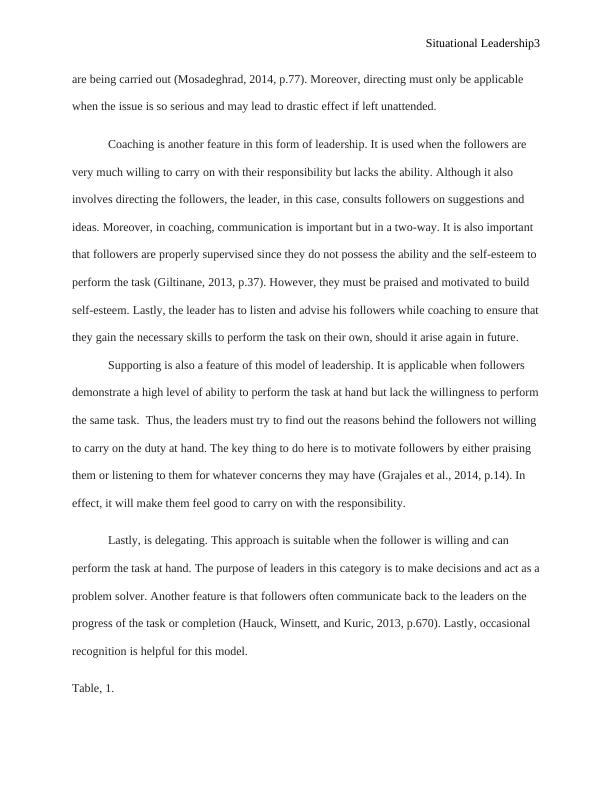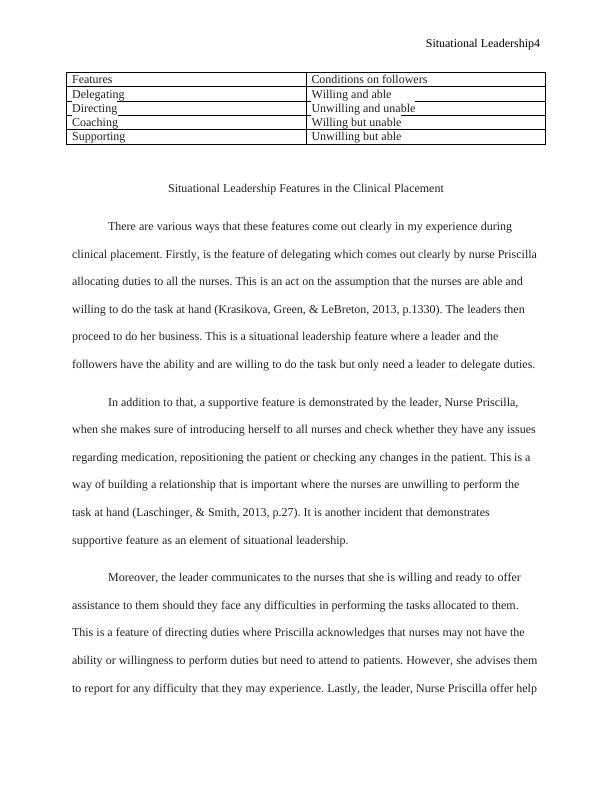Ask a question from expert
Situational Leadership | Assignment
12 Pages3219 Words562 Views
Added on 2020-03-16
Situational Leadership | Assignment
Added on 2020-03-16
BookmarkShareRelated Documents
Situational Leadership1NameSituational LeadershipName of ClassInstructorInstitutionCity and StateDate

Situational Leadership2Question 2.Situational LeadershipThe leadership experience during my clinical practice presents itself in a form similar to situational leadership. Therefore, in this paper, I intend to elaborate on situational leadership and how it relates to the clinical placement. According to scientists, situation leadership entails relationship between leader’s supportive, directive behavior and between the levels of development of the followers. In this approach, supportive behavior entails personal relationship that a leader has with his or her followers. Leaders maintain a relationship with their followers through communication and emotional support. In addition to that, the leaders offer direction to their subjects by elaborating on the roles of members. On the other hand, the development level of the members is a product of their readiness, experiences and their potential to perform the task at hand. It is a crucial aspect that motivates followers to carry on with their responsibility (Blumenthal et al., 2012, p.517). Since the form of leadership involves directive behavior, followers who are enthusiastic are more likely to respond to directives than those that are not enthusiastic. Thus, it can be used in diverse organizations, and more importantly, among nurses. It is the best leadership that fits in my clinical placement experience, and one can find evidence to prove the same.Key features of Situational LeadershipDirecting, it is recommended that this approach can used when the subjects are not so much willing and have a low potential to complete a task at hand. It compels a leader to move in and assume a directive role. However, in directing the roles, the leader ought to elaborate on the roles of each member. In addition to that, the leader has the responsibility to supervise how they

Situational Leadership3are being carried out (Mosadeghrad, 2014, p.77). Moreover, directing must only be applicable when the issue is so serious and may lead to drastic effect if left unattended. Coaching is another feature in this form of leadership. It is used when the followers are very much willing to carry on with their responsibility but lacks the ability. Although it also involves directing the followers, the leader, in this case, consults followers on suggestions and ideas. Moreover, in coaching, communication is important but in a two-way. It is also important that followers are properly supervised since they do not possess the ability and the self-esteem to perform the task (Giltinane, 2013, p.37). However, they must be praised and motivated to build self-esteem. Lastly, the leader has to listen and advise his followers while coaching to ensure thatthey gain the necessary skills to perform the task on their own, should it arise again in future.Supporting is also a feature of this model of leadership. It is applicable when followers demonstrate a high level of ability to perform the task at hand but lack the willingness to performthe same task. Thus, the leaders must try to find out the reasons behind the followers not willing to carry on the duty at hand. The key thing to do here is to motivate followers by either praising them or listening to them for whatever concerns they may have (Grajales et al., 2014, p.14). In effect, it will make them feel good to carry on with the responsibility.Lastly, is delegating. This approach is suitable when the follower is willing and can perform the task at hand. The purpose of leaders in this category is to make decisions and act as aproblem solver. Another feature is that followers often communicate back to the leaders on the progress of the task or completion (Hauck, Winsett, and Kuric, 2013, p.670). Lastly, occasional recognition is helpful for this model.Table, 1.

Situational Leadership4FeaturesConditions on followersDelegatingWilling and ableDirectingUnwilling and unableCoachingWilling but unableSupportingUnwilling but ableSituational Leadership Features in the Clinical PlacementThere are various ways that these features come out clearly in my experience during clinical placement. Firstly, is the feature of delegating which comes out clearly by nurse Priscillaallocating duties to all the nurses. This is an act on the assumption that the nurses are able and willing to do the task at hand (Krasikova, Green, & LeBreton, 2013, p.1330). The leaders then proceed to do her business. This is a situational leadership feature where a leader and the followers have the ability and are willing to do the task but only need a leader to delegate duties.In addition to that, a supportive feature is demonstrated by the leader, Nurse Priscilla, when she makes sure of introducing herself to all nurses and check whether they have any issues regarding medication, repositioning the patient or checking any changes in the patient. This is a way of building a relationship that is important where the nurses are unwilling to perform the task at hand (Laschinger, & Smith, 2013, p.27). It is another incident that demonstrates supportive feature as an element of situational leadership.Moreover, the leader communicates to the nurses that she is willing and ready to offer assistance to them should they face any difficulties in performing the tasks allocated to them. This is a feature of directing duties where Priscilla acknowledges that nurses may not have the ability or willingness to perform duties but need to attend to patients. However, she advises themto report for any difficulty that they may experience. Lastly, the leader, Nurse Priscilla offer help

End of preview
Want to access all the pages? Upload your documents or become a member.
Related Documents
Situational Leadership Theory and Kolb's Theory of Experiential Learninglg...
|8
|1414
|358
Leadership Styles and Approaches in Organizationslg...
|5
|866
|411
Communication Skills in Social Work and Human Services Discussion 1 Interactional Theory of Leadershiplg...
|4
|697
|51
Academic Journal of Human Resourcelg...
|8
|2102
|21
Leadership Report: Theories, Styles, Models, and Impacts on Organisational Culture and Diversitylg...
|9
|2453
|98
Responsible For Stimulating And Inspiringlg...
|14
|2570
|12